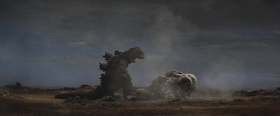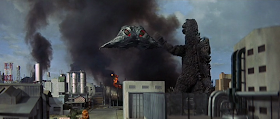The film was released theatrically in the United States in the Spring of 1972 by American International Pictures as Godzilla vs. the Smog Monster.
Plot
The microscopic alien lifeform Hedorah feeds on Earth's pollution and grows into a poisonous, acid-secreting sea monster. After it sinks an oil tanker and attacks Dr. Yano and his young son Ken, scarring them both, Hedorah's toxic existence is revealed to the public. Ken has visions of Godzilla fighting the world's pollution, and insists Godzilla will come to humankind's aid against Hedorah.
Hedorah metamorphoses into an amphibian form, allowing it to move onto land to feed on additional sources of pollution. Hedorah is confronted by Godzilla. Hedorah is easily overpowered by Godzilla and retreats into the sea. It returns shortly thereafter in a flying saucer shape demonstrating new, even deadlier forms which it can switch between at will.
Thousands of people die in Hedorah's raids and even Godzilla is overwhelmed by Hedorah's poisonous emissions. As hope sinks, a party is thrown on Mt. Fuji to celebrate one last day of life before humankind succumbs to Hedorah. Ken realizes that Godzilla and Hedorah have come to Mt. Fuji as well for a final confrontation.
Dr. Yano has determined that drying out Hedorah's body may destroy the otherwise unkillable monster. The JSDF swiftly constructs two gigantic electrodes for this purpose, but their power is cut off by Godzilla and Hedorah's violent battle. Godzilla energizes the electrodes with his atomic ray, dehydrating Hedorah's outer body. Hedorah sheds this outer body and takes flight to escape, but Godzilla propels himself through the air with his atomic ray to give chase. Godzilla drags Hedorah back to the electrodes and continues to dehydrate it until Hedorah dies. Godzilla tears apart Hedorah's dried-out body and dehydrates the pieces until nothing remains but dust.
With Ken calling after him, Godzilla returns to the sea, but not before glaring threateningly at the surviving humanity whose pollution spawned Hedorah. The question arises: Could it happen again?
Cast
Akira Yamauchi as Dr. Toru Yano
Toshio Shiba as Yukio Keuchi
Hiroyuki Kawase as Ken Yano
Keiko Mari as Miki Fujiyama
Toshie Kimura as Toshie Yano
Godzilla, the King of the Monster and the titular kaiju character who comes to Japan's rescue to defeat Hedorah.
Hedorah, the main antagonist of the film and the Smog-Monster, Hedorah is a protean, sludge like enemy from Outer Space.
Production
Kenpachiro Satsuma, the actor who played Hedorah, was struck with appendicitis during the production. Doctors were forced to perform the appendectomy while he was still wearing the Hedorah suit, due to the length of time it took to take off. During the operation, Satsuma learned that painkillers have no effect on him.
On a side note, this was the only time we see Godzilla fly under his own power. He uses his atomic ray as jet propulsion. Director Banno reportedly added the scene to provide a light moment in what is otherwise a fairly dark film compared to many of those which preceded it.
Yoshimitsu Banno was so pleased with Godzilla vs. Hedorah that he started writing another Godzilla film. An unnamed project, dubbed Godzilla vs. Hitodah on the site, was his first attempt, but he abandoned it in favor of a direct sequel to his 1971 Godzilla film called Godzilla vs. Hedorah 2. However, Tomoyuki Tanaka, who was hospitalized during the production of Godzilla vs. Hedorah was extremely dissatisfied with the final product and went as far as to tell Banno that he had "ruined Godzilla." So Tanaka immediately barred Banno from making another Godzilla film. In fact, Banno was never allowed to direct another Toho film again and was reduced to assistant director for Prophecies of Nostradamus (1974) and as overseer of the animated TV show Cashan: Robot Hunter (1988).
According to Banno though, from later interviews conducted with him, Godzilla vs. Hedorah 2 was actually still being worked on after he was removed from the project. Although who the new director would have been is unknown, but Jun Fukuda seems the most likely candidate considering that he would step up to direct the next three Godzilla films. If the film was going to keep its Africa setting at this stage is not known. The project was eventually scrapped, and three more proposed projects would be introduced that following year before finally settling on Godzilla vs Gigan (1972).
 |
| American International Pictures theatrical poster for the 1972 U.S release of Godzilla vs. The Smog Monster. |
The film was released in April 1972 by American International Pictures under the title Godzilla vs. the Smog Monster. There were several small alterations: dialogue was dubbed to English, and the song "Save the Earth" (based on a song in the original Japanese version of the film) was added. This version was rated 'G' by the MPAA, and the same version was given an 'A' certificate by the BBFC for its UK theatrical release in 1975.
The AIP version has been replaced in the North American home video and television markets (including Sony's DVD) by Toho's international version, titled Godzilla vs. Hedorah. This version features a different English dub dubbed by Axis International and also lacks the English-language song, Save the Earth.
Reception
Critical reaction to the film has been mixed, with some embracing its eccentricity and others deriding it.
Japan Hero said the film is "recommended for Godzilla fans, but don't expect much out of it," adding that while "the special effects appear to be pretty good" and "watching it in its original [Japanese] language does make the movie more tolerable," "the character designs ... are bad" and "the music ... really kills the movie." Monster Zero criticized the film's production values and said that it "succeeds in carrying the series over the edge into strictly kid's stuff" and "begins the series' inexorable slide into oblivion." Stomp Tokyo said the film has "many obvious, crippling flaws" but added that "there are some good things," praising the monster action in particular.
American Kaiju called the film "a confused Godzilla non-epic that doesn't seem to be sure just who it was made for in the first place." DVD Talk said it "earns points for trying something new, to break away from what was fast becoming a tired formula. The film isn't as entertaining as Godzilla vs. Gigan or Godzilla vs. Mechagodzilla, but it is more original and daring, and ... fans will want to pick [it] up."
The U.S. dubbed version was featured in the 1978 book The Fifty Worst Films of All Time.
 |
| Haruo Nakajima (Godzilla) and Kenpachiro Satsuma (Hedorah), stage a fight as part of publicity for the film's release in Japan. |
Box Office
In Japan, the film sold 1,740,687 tickets.
Home Media Releases
Kraken Releasing - Blu-Ray
Released: May 6, 2014
Picture: AVC-1080P (2.35:1)
Sound: Japanese and English (DTS-HD Mono)
Subtitles: English
Extra: Original Japanese Theatrical Trailer
Note: 86 Minutes
MPAA Rating: PG for sci-fi monster violence and brief mild language
Sony Pictures DVD
Released: October 19, 2004
Aspect Ratio: Widescreen (2.35:1) Anamorphic
Sound: Japanese (2.0), English (2.0)
Supplements: Trailers for Kaena: The Prophecy, The Lost Skeleton of Cadavra and Steamboy
Region 1
Rated PG for sci-fi monster violence and brief mild language.
DigitalDisc DVD
Released: Unknown
Aspect Ratio: 1.33:1
Sound: English Mono
Supplements: On Double Feature DVD with Godzilla vs. Megalon
Region 1
rated PG for sci-fi monster violence and brief mild language.
Orion Pictures VHS
Released: 1989
Aspect Ratio: 1.33:1
Sound: English Mono
Orion release of AIP's version of the film
Legacy
After Yoshimitsu Banno finished directing Godzilla vs. Hedorah, he began work on creating another installment in the Godzilla series. Like his first Godzilla movie, Banno had wanted the next film to have a strong message against pollution. The initial idea was that a mutant starfish-like monster battles Godzilla. However, he scrapped this idea and wrote what was going to be Godzilla vs. Hedorah 2. In it, Godzilla was to fight another Hedorah, this time in Africa. Due to Tomoyuki Tanaka's reaction to Banno's first Godzilla film, this was never realized.
Director Yoshimitsu Banno spent several years trying to acquire funding for a 40-minute IMAX 3D Godzilla film starring a new version of Hedorah called Deathla. The project was tentatively titled Godzilla 3D: To The Max. With Banno currently working as a producer on Warner Brothers and Legendary Pictures upcoming Godzilla reboot, the Godzilla 3D: To The Max project was scrapped.
Trivia
This was the first Godzilla film made in the 1970s, and the eleventh entry in the series.
This was the first film in several years to neither reuse an old monster (not counting Godzilla) or recycle footage from a previous movie in the series. This is noteworthy since the previous five films (made between 1965-1969) had increasingly done both.
Hedorah's origin is also unique for it is the only monster to be created from pollution.
Hedorah's only other appearance is in Godzilla: Final Wars, where it appears alongside Ebirah in a single scene cameo and is defeated almost immediately. It is never stated what purpose Hedorah has in attacking Tokyo, and it is possible that he was just in the wrong place at the wrong time. In all likelihood, this appearance was merely as an extra monster to make the Xilien forces appear more numerous because the costume was on hand.










.jpg)
No comments:
Post a Comment